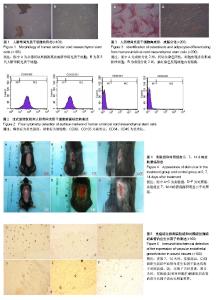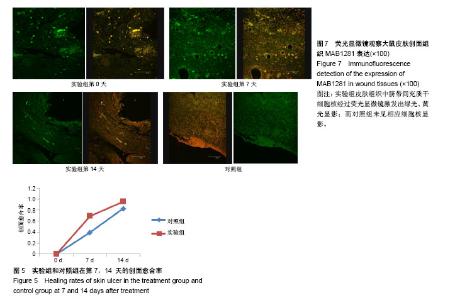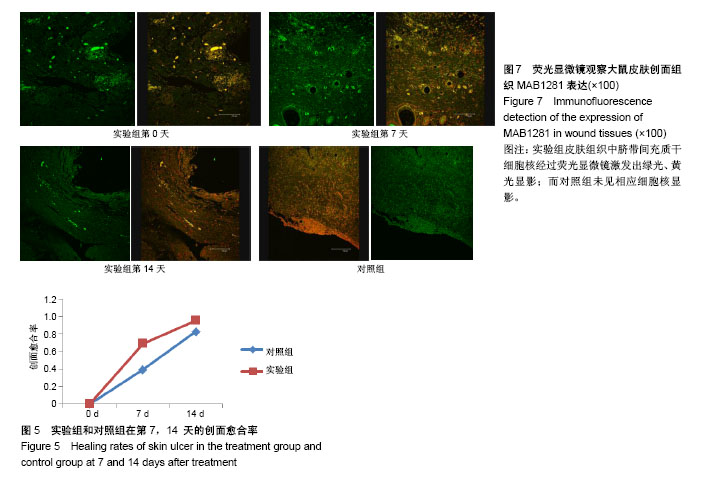| [1] 中华医学会外科分会血管外科学组.慢性下肢静脉疾病诊断与治疗中国专家共识[J].中华普通外科杂志,2014,29(4):246-252.[2] Jiang Y, Huang S, Fu X, et al. Epidemiology of chronic cutaneous wounds in China. Wound Repair Regen. 2011; 19(2):181-188. [3] Ding DC, Chang YH, Shyu WC, et al. Human umbilical cord mesenchymal stem cells: a new era for stem cell therapy. Cell Transplant. 2015;24(3):339-347.[4] Dalous J, Larghero J, Baud O. Transplantation of umbilical cord-derived mesenchymal stem cells as a novel strategy to protect the central nervous system: technical aspects, preclinical studies, and clinical perspectives. Pediatr Res. 2012;71(4 Pt 2):482-490. [5] Wakao S, Matsuse D, Dezawa M. Mesenchymal stem cells as a source of Schwann cells: their anticipated use in peripheral nerve regeneration. Cells Tissues Organs. 2014;200(1): 31-41. [6] Muheremu A, Sun JG, Wang XY,et al.Combined use of Y-tube conduits with human umbilical cord stem cells for repairing nerve bifurcation defects.Neural Regen Res. 2016;11(4): 664-669.[7] Can A, Karahuseyinoglu S. Concise review: human umbilical cord stroma with regard to the source of fetus-derived stem cells. Stem Cells. 2007;25(11):2886-2895. [8] 苏仲奕,杨在亮,汤永永,等.人脐带间充质干细胞修复大鼠放射复合皮肤损伤及其体外致瘤性[J]. 中国组织工程研究, 2014, 18(37):5993-5997.[9] Li T, Xia M, Gao Y, et al. Human umbilical cord mesenchymal stem cells: an overview of their potential in cell-based therapy. Expert Opin Biol Ther. 2015;15(9):1293-1306. [10] 刘奎利,石炳毅,刘德忠,等.大鼠脐带源间充质干细胞的分离及生物学性状[J].中国组织工程研究与临床康复, 2009,32(13 6340-6343.[11] Nicholas MN, Yeung J. Current Status and Future of Skin Substitutes for Chronic Wound Healing. J Cutan Med Surg. 2017;21(1):23-30.[12] Davis FM, Kimball A, Boniakowski A, et al. Dysfunctional Wound Healing in Diabetic Foot Ulcers: New Crossroads. CurrDiab Rep. 2018;18(1):2. [13] Han G, Ceilley R. Chronic Wound Healing: A Review of Current Management and Treatments. AdvTher. 2017; 34(3):599-610. [14] Elloumi-Hannachi I, Yamato M, Okano T. Cell sheet engineering: a unique nanotechnology for scaffold-free tissue reconstruction with clinical applications in regenerative medicine. J Intern Med. 2010;267(1):54-70. [15] Nassar D, Droitcourt C, Mathieu-d'Argent E, et al. Fetal progenitor cells naturally transferred through pregnancy participate in inflammation and angiogenesis during wound healing. FASEB J. 2012;26(1):149-157. [16] Maxson S, Lopez EA, Yoo D, et al. Concise review: role of mesenchymal stem cells in wound repair. Stem Cells Transl Med. 2012;1(2):142-149. [17] Hicks CW, Canner JK, Mathioudakis N, et al. The Society for Vascular Surgery Wound, Ischemia, and foot Infection (WIfI) classification independently predicts wound healing in diabetic foot ulcers. J Vasc Surg. 2018 Apr 2. pii: S0741-5214(18)30279-9. [18] Amini A, Pouriran R, Abdollahifar MA, et al. Stereological and molecular studies on the combined effects of photobiomodulation and human bone marrow mesenchymal stem cell conditioned medium on wound healing in diabetic rats. J Photochem Photobiol B. 2018;182:42-51. [19] Cabrera C, Carriquiry G, Pierinelli C, et al. The role of biologically active peptides in tissue repair using umbilical cord mesenchymal stem cells. Ann N Y Acad Sci. 2012; 1270:93-97. [20] Wang PH, Huang BS, Horng HC, et al. Wound healing. J Chin Med Assoc. 2018;81(2):94-101. [21] Song SY, Chung HM, Sung JH. The pivotal role of VEGF in adipose-derived-stem-cell-mediated regeneration.Expert Opin Biol Ther. 2010;10(11):1529-1537. [22] Qin HL, Zhu XH, Zhang B, et al. Clinical Evaluation of Human Umbilical Cord Mesenchymal Stem Cell Transplantation After Angioplasty for Diabetic Foot. Exp Clin Endocrinol Diabetes. 2016;124(8):497-503.[23] Liang K, Jiang Z, Zhao B, et al. The expression of vascular endothelial growth factor in mast cells promotes the neovascularisation of human pterygia. Br J Ophthalmol. 2012;96(9):1246-1251. [24] Odemis V, Boosmann K, Heinen A, et al. CXCR7 is an active component of SDF-1 signalling in astrocytes and Schwann cells. J Cell Sci. 2010;123(Pt 7):1081-1088. [25] 高峰,张近宝,周凯,等.血管内皮生长因子基因修饰骨髓间充质干细胞移植心肌梗死大鼠:高压氧干预促进治疗性血管生成[J].中国组织工程研究,2012,16(27):5011-5016.[26] 刘军朋,姜文学.骨髓间充质干细胞旁分泌促血管生成的研究进展[J].天津医科大学学报,2011,17(1):130-133.[27] Kwon MJ, An S, Choi S, et al. Effective healing of diabetic skin wounds by using nonviral gene therapy based on minicircle vascular endothelial growth factor DNA and a cationic dendrimer. J Gene Med. 2012;14(4):272-278. [28] Xiong N, Zhang Z, Huang J, et al. VEGF-expressing human umbilical cord mesenchymal stem cells, an improved therapy strategy for Parkinson's disease. Gene Ther. 2011;18(4): 394-402. [29] Hollweck T, Marschmann M, Hartmann I, et al. Comparative analysis of adherence, viability, proliferation and morphology of umbilical cord tissue-derived mesenchymal stem cells seeded on different titanium-coated expanded polytetrafluoroethylene scaffolds. Biomed Mater. 2010;5(6): 065004.[30] Fan W, Crawford R, Xiao Y. The ratio of VEGF/PEDF expression in bone marrow mesenchymal stem cells regulates neovascularization. Differentiation. 2011;81(3): 181-191. [31] Tang JM, Wang JN, Zhang L, et al. VEGF/SDF-1 promotes cardiac stem cell mobilization and myocardial repair in the infarcted heart. Cardiovasc Res. 2011;91(3):402-411. [32] Huang D, Yi Z, He X, et al. Distribution of infused umbilical cord mesenchymal stem cells in a rat model of renal interstitial fibrosis. Ren Fail. 2013;35(8):1146-1150.[33] Mitkari B, Nitzsche F, Kerkelä E, et al. Human bone marrow mesenchymal stem/stromal cells produce efficient localization in the brain and enhanced angiogenesis after intra-arterial delivery in rats with cerebral ischemia, but this is not translated to behavioral recovery. Behav Brain Res. 2014; 259:50-59. [34] Cooke JP, Losordo DW. Modulating the vascular response to limb ischemia: angiogenic and cell therapies.Circ Res. 2015; 116(9):1561-1578. |



